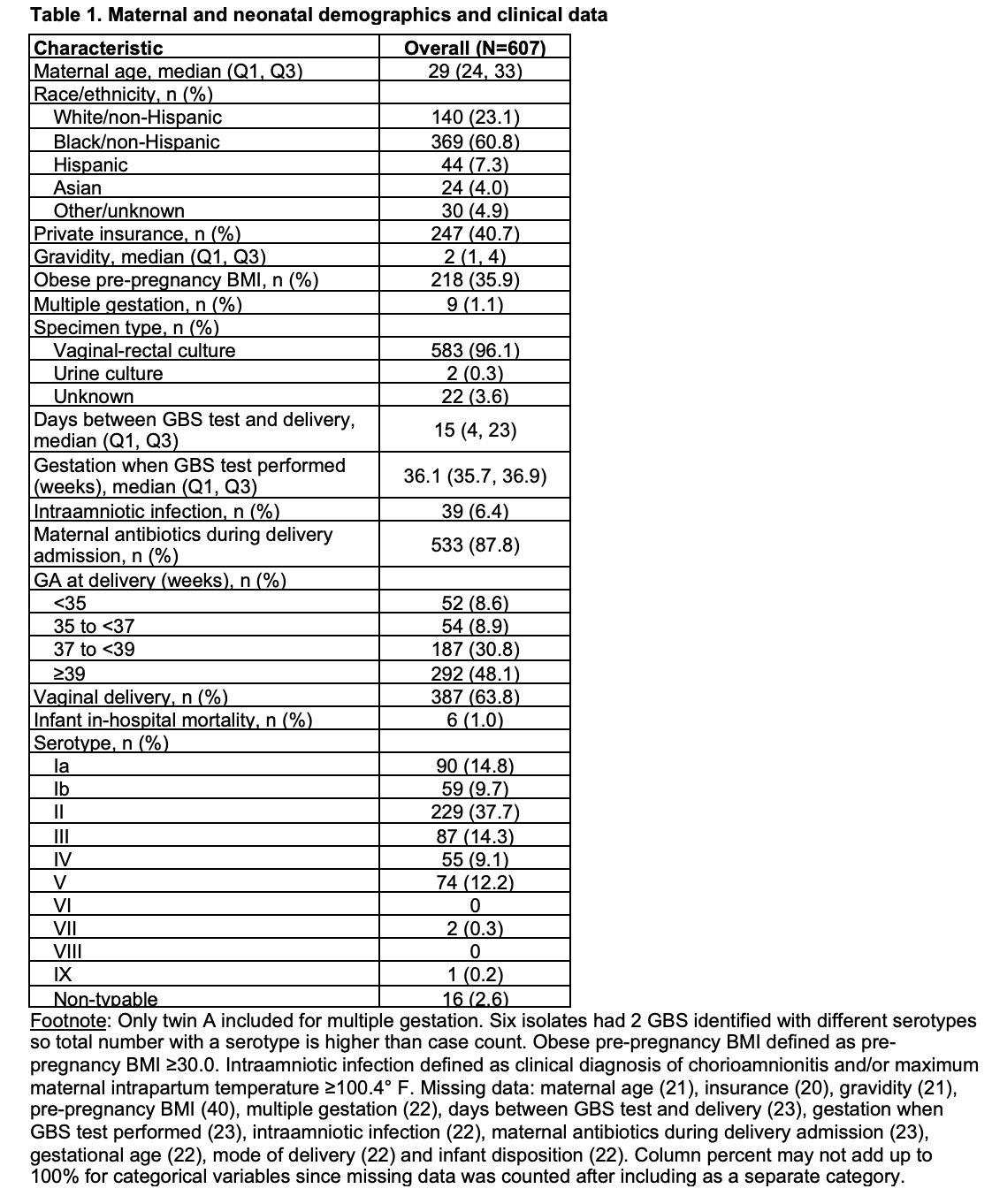Infectious Diseases
Category: Abstract Submission
Infectious Diseases: Bacteria & Antimicrobials
300 - Group B Streptococcus Serotype Prevalence and Associated Risk Factors Among Colonized Pregnant Patients
Friday, April 22, 2022
6:15 PM - 8:45 PM US MT
Poster Number: 300
Publication Number: 300.114
Publication Number: 300.114
Dustin D. Flannery, Childrens Hospital of Philadelphia, Philadelphia, PA, United States; Lesley McGee, Centers for Disease Control and Prevention, Atlanta, GA, United States; Ravi M. Patel, Emory University and Children's Healthcare of Atlanta, Atlanta, GA, United States; Madeline Pfeifer, Children's Hospital of Philadelphia, Philadelphia, PA, United States; Miren B. Dhudasia, Children’s Hospital of Philadelphia, Philadelphia, PA, United States; Sagori Mukhopadhyay, Childrens Hospital of Philadelphia, Philadelphia, PA, United States; Yun F Wang, Emory University/ Grady Health System, Atlanta, GA, United States; We Xing, Centers for Disease Control and Prevention, Atlanta, GA, United States; Li Deng, CDC, Atlanta, GA, United States; Joy N. Rivers, Childrens Hospital of Philadelphia, Atlanta, HI, United States; Julia C. Rhodes, NCIRD/DBD/RDB, Atlanta, GA, United States; Stephanie Schrag, Centers for Disease Control and Prevention, atlanta, GA, United States; Karen M. Puopolo, Childrens Hospital of Philadelphia, Philadelphia, PA, United States
.jpg)
Dustin D. Flannery, DO, MSCE
Assistant Professor of Pediatrics
Children's Hospital of Philadelphia
Philadelphia, Pennsylvania, United States
Presenting Author(s)
Background: Antenatal screening for maternal Group B Streptococcus (GBS) colonization and administration of intrapartum antibiotic prophylaxis reduces risk of neonatal GBS early-onset disease (EOD), but has not eliminated EOD and is not practical in many low-resource settings. Multivalent capsular polysaccharide-based GBS vaccines potentially provide an alternative prevention strategy and candidate vaccines have progressed to phase 2 clinical trials. Recent meta-analyses identified serotype III and Ia as the leading colonizers in the US and worldwide; CDC identifies GBS serotypes III, Ia and II as most common among US cases of neonatal EOD. Current serotype distribution is needed for estimating potential vaccine impact.
Objective: To determine contemporary GBS serotype prevalence among colonized pregnant patients and serotype associations with maternal and neonatal demographic and clinical characteristics.
Design/Methods: Prospective observational study at 3 birth hospitals (2 in Philadelphia, PA and 1 in Atlanta, GA) from 2019-2021. GBS isolated in vaginal-rectal swab or urine culture during pregnancy were collected prior to routine laboratory discard. De-identified maternal and neonatal data were abstracted from medical records. Serotyping was performed by Lancefield grouping and/or real-time PCR. Serotype prevalence was quantified using summary statistics and factors associated with colonization by specific serotypes were determined by Kruskal-Wallis test, Chi-squared test, or Fisher’s exact test as appropriate.
Results: GBS isolates from 607 pregnant patients were included. Clinical and demographic data are shown in Table 1. Cultures were performed at a median of 36.1 weeks’ gestation and median of 15 days before delivery. Serotype II was predominant at 37.4%, followed by Ia (14.7%); III (14.2%); V (12.1%); Ib (9.6%); and IV (9.0%) (Table 1). 533 (87.8%) pregnant patients received antibiotics during delivery admission and no infants born to study patients were diagnosed with GBS EOD. Median age and racial/ethnic distribution of colonized patients varied by colonizing serotype (Table 2). Cohort frequency of amniotic infection was 6.4% and did not differ by serotype (Table 2).Conclusion(s): The 3 most common GBS serotypes in this study of colonizing isolates are consistent with those most frequently isolated in cases of neonatal EOD identified through recent CDC national surveillance. Colonization with serotypes II and IV was more common compared to previous estimates. A hexavalent GBS vaccine including serotypes Ia-V would potentially provide coverage for 97% of colonized pregnant patients in this study.
Table 1. Maternal and neonatal demographics and clinical data
Table 2: Factors associated with colonization with common GBS serotypes.png)
Objective: To determine contemporary GBS serotype prevalence among colonized pregnant patients and serotype associations with maternal and neonatal demographic and clinical characteristics.
Design/Methods: Prospective observational study at 3 birth hospitals (2 in Philadelphia, PA and 1 in Atlanta, GA) from 2019-2021. GBS isolated in vaginal-rectal swab or urine culture during pregnancy were collected prior to routine laboratory discard. De-identified maternal and neonatal data were abstracted from medical records. Serotyping was performed by Lancefield grouping and/or real-time PCR. Serotype prevalence was quantified using summary statistics and factors associated with colonization by specific serotypes were determined by Kruskal-Wallis test, Chi-squared test, or Fisher’s exact test as appropriate.
Results: GBS isolates from 607 pregnant patients were included. Clinical and demographic data are shown in Table 1. Cultures were performed at a median of 36.1 weeks’ gestation and median of 15 days before delivery. Serotype II was predominant at 37.4%, followed by Ia (14.7%); III (14.2%); V (12.1%); Ib (9.6%); and IV (9.0%) (Table 1). 533 (87.8%) pregnant patients received antibiotics during delivery admission and no infants born to study patients were diagnosed with GBS EOD. Median age and racial/ethnic distribution of colonized patients varied by colonizing serotype (Table 2). Cohort frequency of amniotic infection was 6.4% and did not differ by serotype (Table 2).Conclusion(s): The 3 most common GBS serotypes in this study of colonizing isolates are consistent with those most frequently isolated in cases of neonatal EOD identified through recent CDC national surveillance. Colonization with serotypes II and IV was more common compared to previous estimates. A hexavalent GBS vaccine including serotypes Ia-V would potentially provide coverage for 97% of colonized pregnant patients in this study.
Table 1. Maternal and neonatal demographics and clinical data

Table 2: Factors associated with colonization with common GBS serotypes
.png)
